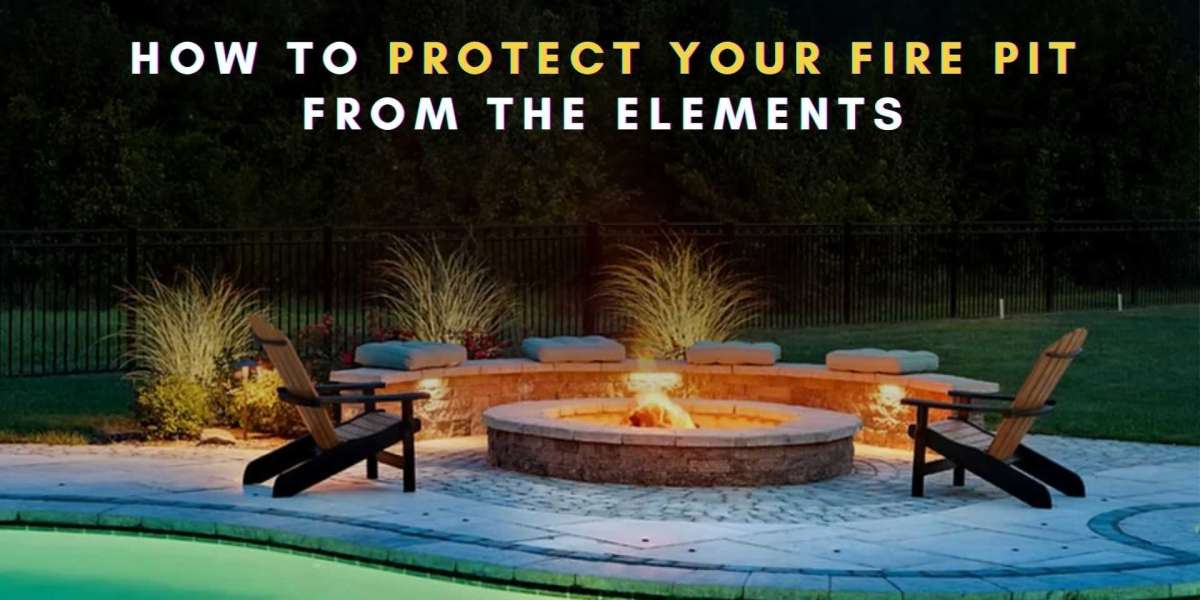Fire pits are a staple for enhancing outdoor spaces, offering a warm and inviting ambiance. However, exposure to rain, snow, wind, and UV rays can significantly damage fire pits, affecting their longevity and performance. Whether you own a gas fire pit, a wood-burning fire pit, or a weather-resistant option, proper maintenance and protection against the elements are crucial.
Why Weather Protection Matters
Weather elements like rain, snow, and sun can deteriorate the structural integrity of fire pits. Rust, corrosion, and material weakening are common outcomes of prolonged exposure. Proper weather protection ensures safety, enhances performance, and maintains the visual appeal of your fire pit.
Understanding Fire Pit Types and Their Vulnerabilities
Gas Fire Pits
Gas fire pits are prone to damage when exposed to water. Moisture can infiltrate burners and gas lines, posing safety risks and reducing efficiency.
Wood-Burning Fire Pits
Rain and snow can cause wood-burning fire pits to rust and accumulate moisture, leading to inefficient burns and compromised structural integrity.
Metal Fire Pits
Metal fire pits, particularly those made from steel or cast iron, are susceptible to rust and corrosion. Regular upkeep and protective coatings are essential for these models.
Key Features of Weather-Resistant Fire Pits
Weather-resistant fire pits are specifically designed to withstand harsh conditions. Look for:
- Rust-proof materials like stainless steel or powder-coated metals.
- Drainage systems to prevent water accumulation.
- Heat-resistant finishes to endure temperature changes.
Selecting the Ideal Location
Sheltered Spaces
Positioning your fire pit under a covered patio or pergola minimizes direct exposure to rain and UV rays.
Drainage and Elevation
Install your fire pit on elevated ground to prevent water pooling. Adequate drainage ensures that the area remains dry, reducing the risk of rust.
The Importance of Protective Covers

Investing in a high-quality fire pit cover is essential to protecting your investment. Look for covers that are:
- Made from waterproof and UV-resistant materials.
- Fitted with secure fastenings to withstand strong winds.
- Easy to use and store when not in use.
Seasonal Maintenance Guidelines
Winter Precautions
- Clean your fire pit thoroughly before the winter season.
- Use insulated covers to shield against freezing temperatures.
- Store portable fire pits indoors when not in use.
Summer Maintenance Tips
- Protect against prolonged sun exposure with UV-resistant covers.
- Remove dirt, pollen, and other debris regularly.
- Inspect burners and connections for gas fire pits to ensure proper functioning.
Durable Materials for Fire Pits
Choosing robust materials can make all the difference in maintaining a fire pit that lasts for years. Consider these options:
- Stainless Steel: Highly resistant to rust and heat.
- Copper: Offers natural weather resistance and develops an appealing patina over time.
- Concrete: Durable but may require sealing to prevent water damage.
Cleaning and Restoring Fire Pits
Regular cleaning preserves the functionality and appearance of your fire pit. Follow these steps:
- Cleaning ash, soot, and other things can be done with a soft cloth or brush.
- Apply a rust-resistant spray for metal surfaces.
- For gas fire pits, ensure all components are dry before use.
Avoiding Common Mistakes
- Don't leave ashes in the fire pit for extended periods, as they can absorb moisture and accelerate rusting.
- Avoid using abrasive cleaning materials that may scratch the surface.
- Never operate a fire pit in a damp or waterlogged state, as this can compromise safety.
Long-Term Benefits of Proper Maintenance
By prioritizing care and protection, you'll enjoy numerous advantages:
- Enhanced Durability: A well-maintained fire pit lasts significantly longer.
- Consistent Performance: Ensures safe and efficient operation.
- Cost Savings: Lessens the need for fixes or replacements to be done often.
Choosing the Right Firewood for Protection
While weatherproofing measures are crucial, selecting the correct type of firewood can also minimize damage to your fire pit. Hardwoods like oak and hickory make less creosote and soot, which keeps waste from building up. Avoid using treated wood, which can release harmful chemicals and accelerate corrosion when mixed with moisture. Proper firewood choice improves efficiency and protects your fire pit's internal surfaces from excessive wear and tear.
Monitoring Humidity Levels
Humidity is an often-overlooked factor in fire pit maintenance. Even without rain or snow, high moisture levels in the air can promote rust on metal fire pits. Invest in a dehumidifier for outdoor storage spaces or store your fire pit in a garage or shed during periods of prolonged humidity. If outdoor storage is your only option, ensure your fire pit is covered with a moisture-proof tarp to mitigate the effects of damp conditions.
Advanced Coating Options for Fire Pits
For metal fire pits, applying advanced coatings can provide an extra layer of protection:
- High-Temperature Paints: These can shield metal surfaces from heat damage and prevent rust.
- Ceramic Coatings: Commonly used in automotive applications, they can provide robust resistance to weather elements.
- Powder Coating: A long-lasting option that resists peeling and chipping under extreme conditions.
Consult professionals on the best coating options tailored to your fire pit's material.
Preventing Wind Damage
Wind can cause debris to enter the fire pit, leading to blockages or scratches on its surface. Installing a wind guard is an effective solution, especially for gas fire pits. These glass or metal barriers shield flames and components, ensuring a safe and efficient burn. Additionally, avoid placing your fire pit in areas prone to strong winds, such as open fields or unprotected terraces.
Building a Dedicated Fire Pit Enclosure

For long-term protection, consider constructing a fire pit enclosure or housing. This can be a custom-built stone, brick, or metal structure surrounding your fire pit, acting as a buffer against the elements. Enclosures add an aesthetic appeal and shield your fire pit from direct rain, snow, and UV rays.
Eco-Friendly Fire Pit Protection Measures
Adopting eco-friendly practices can align your fire pit maintenance with sustainable living. For instance:
- Recycled Fire Pit Covers: Made from eco-friendly materials, these covers reduce your carbon footprint.
- Natural Cleaning Solutions: Use vinegar or baking soda instead of chemical cleaners to maintain surfaces.
- Solar-Powered Ventilation: Solar-powered vents can prevent moisture accumulation in enclosed fire pits.
Addressing Specific Weather Challenges
Heavy Rain
- Ensure your fire pit has proper drainage holes to prevent water pooling.
- Angle covers to allow water runoff instead of accumulation.
Snow and Ice
- Use insulated fire pit covers specifically designed for freezing temperatures.
- Avoid using sharp tools to remove ice, as they can scratch the fire pit surface.
Intense Heat and Sunlight
- Position your fire pit in shaded areas or use UV-resistant covers to prevent fading and heat-related wear.
Enhancing Outdoor Aesthetics with Protective Features
While focusing on protection, you can also improve your outdoor space's visual appeal. Select fire pit covers and accessories that match your patio decor. Decorative wind guards, handmade enclosures, and stylish covers can make something valuable look good.
Protecting your fire pit from the elements is not just about aesthetics; it's about ensuring safety, longevity, and optimal performance. By understanding your fire pit's vulnerabilities and investing in weather-resistant fire pits, you can enjoy cozy outdoor moments for years. From choosing durable materials to adopting seasonal maintenance routines, every effort contributes to the enduring functionality of your fire pit.
FAQs
1. What are the best materials for weather-resistant fire pits?
Stainless steel, copper, and concrete are excellent choices for durability.
2. How can I protect my fire pit during heavy rain?
Use a waterproof cover and ensure proper drainage around the fire pit.
3. Should I clean my fire pit after every use?
Yes, removing ash and debris after each use helps maintain its condition.
4. Can I leave my fire pit outdoors year-round?
Yes, but using a protective cover is essential to minimize weather damage.
5. How often should I inspect my gas fire pit?
Check your gas fire pit monthly for leaks, burner issues, and safety.














